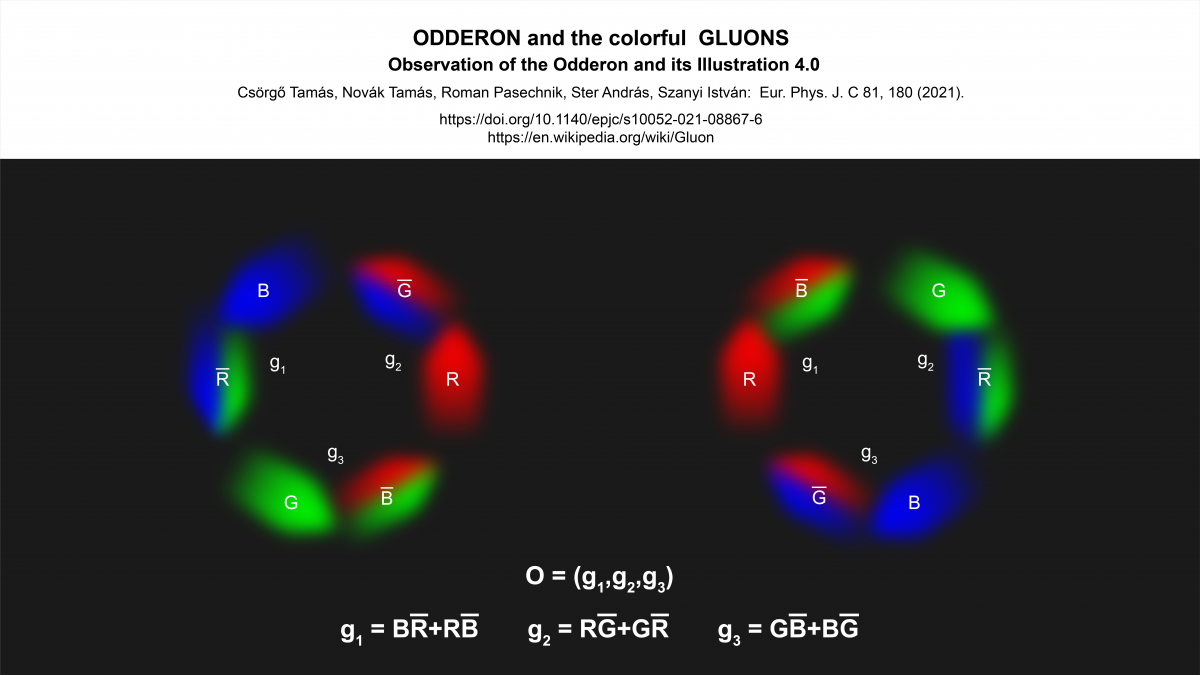An Odd New Result of Hungarian and Swedish Researchers: Discovery of a long awaited but totally surprising new particle, the Odderon
48 years after the first prediction, after a long lasting and intense international competition, four Hungarian physicists and their Swedish colleauge published, for the first time, decisive evidence for the existence of an elusive new particle, the so-called Odderon. This result implies the existence of several, other, new kind of strongly interacting particle states, too. The discovery of the Odderon has just been published in the respected European Physical Journal, EPJ C.
"This result seems to be particularly important: as far as we know, this is a totally unexpected and surprizing discovery, based on recent measurements at the CERN LHC accelerator. Our result may open a new chapter in the study of strong interactions” – according to Tamás Csörgő, a physicist, Member of the Academy of Europe (London), who heads the Hungarian team from the Wigner Reserch Center for Physics, Budapest and the MATE Institute of Technology, Gyöngyös, Hungary.
"The Odderon discovery marks an important milestone in our understanding of the deep mysteries of the strong interactions” – added Roman Pasechnik, senior lecturer, docent at the University of Lund, Lund, Sweden, who acted as the corresponding author of the publication.
The observation of the Odderon
The possible existence of the Odderon was proposed in 1973 by L. Lukaszuk and B. Nicolescu, based on theoretical considerations. However, physicists had to wait 48 years, untill 2021, before finding experimental evidence for the existence of the Odderon. In a tight, global competition, a team consisting of four Hungarian and a Swedish researchers published evidence for the observation of the Odderon.This team has re-analyzed previously published experimental data by the TOTEM and the D0 Collaborations. They have utilized a new and innovative method, invented by the Hungarian team, to winnow down the wealth of these data to the Odderon signal.
The TOTEM experiment at the CERN LHC accelerator joined efforts with the D0 experiment at the Tevatron accelerator in the US and submitted for a publication a manuscript, co-authored by 463 scientists, that finds evidence for the Odderon signal based on new experimental data. This paper utilized manpower and financial resources that were well beyond the reach of the Hungarian and Swedish team. This manuscript is currently under anonymous peer-review in a prestigeous physics journal, but it has not yet been published.
"The goal of fundamental research is not to make profit, but to reach a deeper level of understanding of the world that surrounds us, and to bring new relationships to light. These results close a scientific question that has been open for 48 years. They imply a small but significant difference in the interaction of matter and antimatter, within the otherwise well-known Standard Model of particle physics”- explained Tamás Novák, PhD, associate professor of the MATE Institute of Technology, Gyöngyös, Hungary.
What is the Odderon and what is the significance of its discovery?
According to modern physics, all the interactions are mediated by exchanges of messanger particles. For example, the well known electromagnetism can be described by the exchanges of photons, quanta of light. "Due to Odderon exchange, a small difference appears between elastic proton-proton and elastic proton-antiproton collisions. For the first time, this difference has been quantified in a published paper precisely enough to match the strict scientific criteria needed for a discovery in particle physics” – said András Ster, a physicist from the Wigner Research Centre for Physics, Budapest, Hungary.
In elastic collisions, particles exchange energy and momenta without changing their identity. To illustrate this process, we may use the example of selling a car: Before the deal, Peter has the car, Paul has the money. After the deal, Peter has the money and Paul has the car. If the car is bought by Anti-Paul, who has to borrow the money, a small difference appears. After the deal, Peter will have the same amount of money as in the previous example and Anti-Paul will have the same car. The difference between these two kind of deals is the interest, that Anti-Paul has to pay for his credit. In this illustrative example, Peter and Paul represent the two colliding protons, Anti-Paul illustrates the anti-protons. The money and the car represent the exchanged energy and momenta, and the difference between the two kind of deals, the interest payed for the credit line of Anti-Paul corresponds to the Odderon-exchange. Without the Odderon-exchange the process of elastic proton-proton and elastic proton-antiproton collisions would be identical at the enormous TeV energy scales that characterize these collisions at the LHC and the Tevatron accelerators. Thus the existence of the Odderon violates one of the symmetries of particle physics.
"Out of light, one cannot make matter, bound states, little rings of light, as light is not self-interacting. However, the messenger particles of the strong interactions, the gluons are self-interacting and our result indicates that it is possible to make small, locally colored but overall white rings out of them. According to our results, not only an even but also an odd number of gluons may form such a ring. It is possible to discover it from Hungary, too, not only from Budapest, but even from the Hungarian countryside and from Ukraine. One needs at least three, odd number of gluons to do this” – explained I. Szanyi, PhD student at the Eötvös University, Budapest, Hungary, and young researcher at the Wigner Research Centre for Physics, Budapest, Hungary who received his BSc from the Uzhgorod National University of Ukraine.
Last, but not least, the collaborative partnership with the Tevatron experiment D0 and the CERN LHC experiment TOTEM has to be emphasized. In this aspect, it is important to stress that the main conclusion, the discovery of the Odderon is the same in both scientific manuscripts. Indeed, it seems that a new chapter is being opened in the field of the strong interactions, due to the nearly simultaneous discovery of the Odderon by several teams.
We may hope, that the publication of the discovery of the Odderon brings not only a deeper level of understanding of a long lasting scientific problem, but also a little bit of satisfaction and happiness for the tax-payers and organizations that fund science all over the world.




